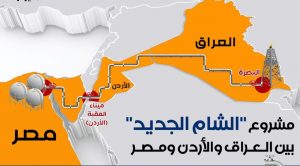A NEW CENTRAL ALLIANCE BETWEEN TWO AXES

By General Monzer El Ayoubi
Translation: Dr Pierre A. Sarkis

The middle East and the region are currently witnessing the beginning of a geopolitical movement with relative convergence, similar to the slide of tectonic plates according to geophysics, allowing changes to regional features and addressing distortions through filling the seismic plates of issues of conflict, ensuring temporary stability. In geological phenomena, the confluence or convergence of two plates may lead to the emergence of new topographic features, such as, the formation of mountains, valleys, etc… In parallel, the accumulation of pressure in the ground may release magma outwards causing volcanoes to appear with serious cracks in the earth’s crust.
Starting with this approach, it appears that the New Levant Project consisting of Egypt, Jordan and Iraq is a new dynamic pact that may lead towards broader strategic political understandings, albeit based on foundations of economic and trade partnerships coinciding with the coordination of investments in energy resources, such as oil, gas and other resources. In this respect, a good example is the extension of the oil pipeline from the port of Basra in Southern Iraq to the port of Aqaba in Jordan, and then to Egypt. The New Levant Project also provides integration among the three countries with deepening security and military cooperation, especially in the fight against terrorism and extremist organizations, such as, ISIS (Islamic State in Iraq and Syria), AL-Nusra, the Army of the Caliphate, etc…
On the other hand, if the dynamism of the geo-dynamic system which allows tectonic plates to move is known scientifically according to the difference in the relative density of the Asthenosphere and the decline of earth’s mantle heat, the driving mechanism for forming a tripartite political alliance in its strategic dimensions is not far from the positives for reducing the negative effects of the region’s conflicts, while achieving prosperity and social stability. It also touches on a central political position with relative independence with its isotopic configuration, which is trying to distance itself from the so-called Iran-led Axis of Resistance, and the corresponding Arab Axis led by Saudi Arabia with American support. At the same time, it establishes a balance in the relationship between them while describing the “relationship” as being good or neutral, within preliminary Iraqi warnings not to get involved in the process of normalization of relations with the Israeli enemy for a number of political and internal reasons, not the least being the common historical roots with Iran and the composition of the social fabric, with the religious sectarian and ideological roots of the Iraqi people. From its historical perspective, the region has held several names including Mesopotamia, the Fertile Crescent, Greater Syria, Bilad El-Sham, the Levant, in accordance with the stages of its entities’ expansion or decline against a backdrop of the lofty language and homogeneity of the environment, as well as, the cultural and social overlap which is integrated politically and religiously. The unity of this region has been a premonition despite the failure of several attempts at that in the past century, for it forms from the nationalistic perspective the hardcore of Arab unity when it was the desired goal.
Next, and despite the fact that issues await the right timing, this trilateral alliance, from what the region is witnessing and what is being planned for it to the beat of military flare: first, with The War in Yemen, the Gaza War, security tension in Iraq, Israeli air raids on Syria, the recent US air strike on the camps of the Popular Mobilization in Iraq, the bombing of US bases, etc… or the commotion of the escalation of the political conflict; second, the Iranian elections being decided in favor of conservatives, Lebanon and the obstacles to forming a new government, Syria and the decisions of the Astana Conference leading to a political solution and the shape of the state, Israel and the formation of the new government after the removal of ex-Prime Minister Benjamin Netanyahu, Jordan and the failed coup message, etc… will be expanding later to include at least Syria and Lebanon with what geography dictates, and the arrangements that are being made for how the region is to be managed by a Russian-Iranian-Turkish consensus, without provoking any Gulf Countries’ opposition or objection, and without any US flaws in satisfying Israel.
In a related context, if the era, time and events differ, the regional strategic geopolitical situation and its distinct composition has always been a magnetic stress field, flexible at times, and precarious at others, an axis for conflicts and impetus for wars to which applies a line of poetry by famous Arabic poet Al Mutanabi “the circumstances of times are diverse on you… and your state is one and only at all times”, which begs the question: is the region moving to a conflict of alliances or axes? Or is some new leverage being prepared to whomever the beneficiary is, since winning or losing is the same thing.
In parallel, did the tripartite summit establish a new alliance similar to the Baghdad Pact which was established in the 1950’s during the Cold War, and included Turkey, Iran, Iraq, Pakistan and the United Kingdom with the aim to curb Soviet communist expansion at the time? This raises the presumption of the other objectives of the coalition through an implicit decision to separate the natural geographical repositioning and the political and military correlation, whether voluntary or forced, as revealed in the closure of the strategic logistic corridor, Iran- Iraq- Syria- Lebanon which allows the isolation of Syria and Lebanon through the Iraqi-Jordanian-Egyptian cordon which stresses the importance of the Iraqi role in both locations as a key crossroad. Keeping in mind that this decision, in case it exists and is applied on the ground, does not imply an inevitable confrontation between the two axes, but may be a step that Iran does not mind at the stage of the forthcoming settlements, which provides a path anew for the latter towards the nuclear agreement and the lifting of US sanctions on Tehran.
As from the Gulf perspective, the New Levant will not be a worrisome concern as long as its three countries are in close contact, and coordinate adequately with the Gulf Cooperation Council (GCC). Conversely, the summit achieved some kind of geo-strategic balance between Egypt and Turkey, with the latter trying to establish its military presence and political influence in Libya; it also afforded Iraq a margin of independence from Iranian influence. The closing final statement stressed the centrality of the Palestinian cause and the need to activate efforts to achieve a comprehensive peace treaty within the two-state solution, as well as, the emphasis on Jordan’s historic Hashemite guardianship and protection of the religious sites in occupied Jerusalem.
In concluding, Lebanon is located on a major seismic fault that extends from the Red Sea in the South to Turkey in the North, and is geopolitically situated in an off-balance position on the hot fault of the region’s axes. As for the domestic political differences between the parties, they come at the expense of the Lebanese people, within the mechanism of achieving personal interests under the pretext of preserving the rights of this or that sect, not to mention the lack of accountability and the covering up of the crimes of corruption associated with stealing people’s money and the loss of the basics of a decent life. Furthermore, since there is no hope for any violent change through a “revolution from beneath”, and any change through the upcoming parliamentary elections may come shy without guaranteed results, because of the brutality of the ruling class in its adherence to its positions, and after the failure of initiatives and mediations through European or domestic sources to achieve any practical progressive step to form a government, and proceed with accountability and reforms, it seems that the best most effective solution is to ask the National Center for Geophysics at the Center for Scientific Research to stimulate a series of successive earthquakes with a degree of 9 on the Richter Scale, for perhaps, it may lead to the destruction of the oligarchical idols and the holders of idol theories in political science and constitutions allowing for the ascendancy of youthful, transparent, confident, and competent minds to assume the rebuilding of a new Lebanon, on the ruins of the outdated Taif Accord.
Scholar in Security and Strategic Affairs
Beirut, 29/06/2021

